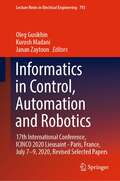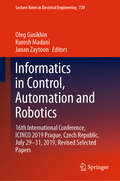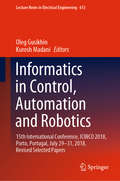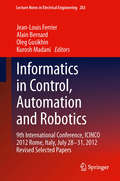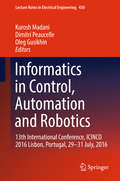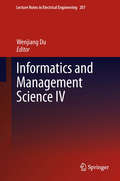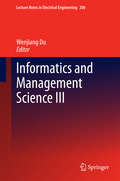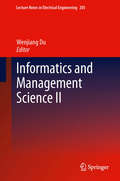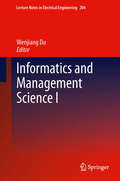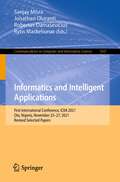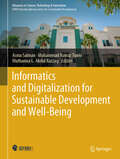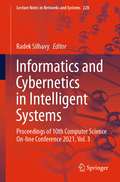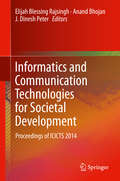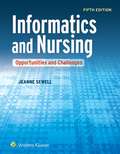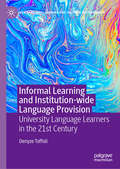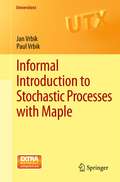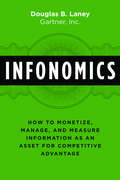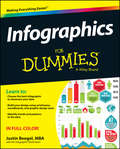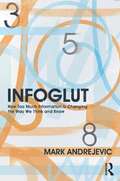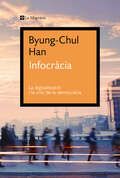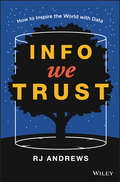- Table View
- List View
Informatics in Control, Automation and Robotics: 17th International Conference, ICINCO 2020 Lieusaint - Paris, France, July 7–9, 2020, Revised Selected Papers (Lecture Notes in Electrical Engineering #793)
by Oleg Gusikhin Kurosh Madani Janan ZaytoonThe book focuses the latest endeavours relating researches and developments conducted in fields of Control, Robotics and Automation. Through more than ten revised and extended articles, the present book aims to provide the most up-to-date state-of-art of the aforementioned fields allowing researcher, PhD students and engineers not only updating their knowledge but also benefiting from the source of inspiration that represents the set of selected articles of the book.The deliberate intention of editors to cover as well theoretical facets of those fields as their practical accomplishments and implementations offers the benefit of gathering in a same volume a factual and well-balanced prospect of nowadays research in those topics. A special attention toward “Intelligent Robots and Control” may characterize another benefit of this book.
Informatics in Control, Automation and Robotics: 16th International Conference, ICINCO 2019 Prague, Czech Republic, July 29-31, 2019, Revised Selected Papers (Lecture Notes in Electrical Engineering #720)
by Oleg Gusikhin Kurosh Madani Janan ZaytoonThis book focuses on the latest endeavors relating researches and developments conducted in fields of control, robotics and automation. Through more than ten revised and extended articles, the present book aims to provide the most up-to-date state of the art of the aforementioned fields allowing researcher, Ph.D. students and engineers not only updating their knowledge but also benefiting from the source of inspiration that represents the set of selected articles of the book.The deliberate intention of editors to cover as well theoretical facets of those fields as their practical accomplishments and implementations offers the benefit of gathering in the same volume a factual and well-balanced prospect of nowadays research in those topics. Special attention toward “Intelligent Robots and Control” may characterize another benefit of this book.
Informatics in Control, Automation and Robotics: 15th International Conference, ICINCO 2018, Porto, Portugal, July 29-31, 2018, Revised Selected Papers (Lecture Notes in Electrical Engineering #613)
by Oleg Gusikhin Kurosh MadaniThe goal of this book is to familiarize readers with the latest research on, and recent advances in, the field of Informatics in Control, Automation and Robotics. It gathers a selection of papers highlighting the state-of-the-art in Intelligent Control Systems, Optimization, Robotics and Automation, Signal Processing, Sensors, Systems Modelling and Control. Combining theoretical aspects with practical applications, the book offers a well-balanced overview of the latest achievements, and will provide researchers, engineers and PhD students with both a vital update and new inspirations for their own research.
Informatics in Control, Automation and Robotics
by Alain Bernard Oleg Gusikhin Kurosh Madani Jean-Louis FerrierThis book includes extended and revised versions of a set of selected papers from the Ninth International Conference on Informatics in Control Automation and Robotics (ICINCO 2012), held in Rome, Italy, from 28 to 31 July 2012. The conference was organized in four simultaneous tracks: Intelligent Control Systems and Optimization, Robotics and Automation, Systems Modeling, Signal Processing and Control and Industrial Engineering, Production and Management. ICINCO 2012 received 360 paper submissions, from 58 countries in all continents. From these, after a blind review process, only 40 were accepted as full papers, of which 20 were selected for inclusion in this book, based on the classifications provided by the Program Committee. The selected papers reflect the interdisciplinary nature of the conference as well as the logic equilibrium between the four abovementioned tracks. The diversity of topics is an important feature of this conference, enabling an overall perception of several important scientific and technological trends.
Informatics in Control, Automation and Robotics
by Dimitri Peaucelle Oleg Gusikhin Kurosh MadaniThe book addresses the latest advances in research and development in the field of informatics in control, robotics and automation. With more than twenty revised and extended articles covering the theoretical aspects as well as applications and their implementation, it offers a factual and well-balanced overview of the state of the art in the field. In addition, it highlights the trends in control of intelligent robots. The book is an up-to-date source of information and inspiration for researchers, engineers and PhD students.
Informatics and Management Science V: 208 (Lecture Notes in Electrical Engineering)
by Wenjiang DuThe International Conference on Informatics and Management Science (IMS) 2012 will be held on November 16-19, 2012, in Chongqing, China, which is organized by Chongqing Normal University, Chongqing University, Shanghai Jiao Tong University, Nanyang Technological University, University of Michigan, Chongqing University of Arts and Sciences, and sponsored by National Natural Science Foundation of China (NSFC). The objective of IMS 2012 is to facilitate an exchange of information on best practices for the latest research advances in a range of areas. Informatics and Management Science contains over 600 contributions to suggest and inspire solutions and methods drawing from multiple disciplines including:<P><P> Computer Science<P> Communications and Electrical Engineering<P> Management Science<P> Service Science<P> Business Intelligence<P> Management Science<P> Service Science<P> Business Intelligence<P>
Informatics and Management Science V
by Wenjiang DuThe International Conference on Informatics and Management Science (IMS) 2012 will be held on November 16-19, 2012, in Chongqing, China, which is organized by Chongqing Normal University, Chongqing University, Shanghai Jiao Tong University, Nanyang Technological University, University of Michigan, Chongqing University of Arts and Sciences, and sponsored by National Natural Science Foundation of China (NSFC). The objective of IMS 2012 is to facilitate an exchange of information on best practices for the latest research advances in a range of areas. Informatics and Management Science contains over 600 contributions to suggest and inspire solutions and methods drawing from multiple disciplines including: Computer Science Communications and Electrical Engineering Management Science Service Science Business Intelligence
Informatics and Management Science IV: 207 (Lecture Notes in Electrical Engineering)
by Wenjiang DuThe International Conference on Informatics and Management Science (IMS) 2012 will be held on November 16-19, 2012, in Chongqing, China, which is organized by Chongqing Normal University, Chongqing University, Shanghai Jiao Tong University, Nanyang Technological University, University of Michigan, Chongqing University of Arts and Sciences, and sponsored by National Natural Science Foundation of China (NSFC). The objective of IMS 2012 is to facilitate an exchange of information on best practices for the latest research advances in a range of areas. Informatics and Management Science contains over 600 contributions to suggest and inspire solutions and methods drawing from multiple disciplines including:<P><P> Computer Science<P> Communications and Electrical Engineering<P> Management Science<P> Service Science<P> Business Intelligence<P> Management Science<P> Service Science<P> Business Intelligence<P>
Informatics and Management Science III: 206 (Lecture Notes in Electrical Engineering)
by Wenjiang DuThe International Conference on Informatics and Management Science (IMS) 2012 will be held on November 16-19, 2012, in Chongqing, China, which is organized by Chongqing Normal University, Chongqing University, Shanghai Jiao Tong University, Nanyang Technological University, University of Michigan, Chongqing University of Arts and Sciences, and sponsored by National Natural Science Foundation of China (NSFC). The objective of IMS 2012 is to facilitate an exchange of information on best practices for the latest research advances in a range of areas. Informatics and Management Science contains over 600 contributions to suggest and inspire solutions and methods drawing from multiple disciplines including:<P><P> Computer Science<P> Communications and Electrical Engineering<P> Management Science<P> Service Science<P> Business Intelligence<P> Management Science<P> Service Science<P> Business Intelligence<P>
Informatics and Management Science II: 205 (Lecture Notes in Electrical Engineering)
by Wenjiang DuThe International Conference on Informatics and Management Science (IMS) 2012 will be held on November 16-19, 2012, in Chongqing, China, which is organized by Chongqing Normal University, Chongqing University, Shanghai Jiao Tong University, Nanyang Technological University, University of Michigan, Chongqing University of Arts and Sciences, and sponsored by National Natural Science Foundation of China (NSFC). The objective of IMS 2012 is to facilitate an exchange of information on best practices for the latest research advances in a range of areas. Informatics and Management Science contains over 600 contributions to suggest and inspire solutions and methods drawing from multiple disciplines including:<P><P> Computer Science<P> Communications and Electrical Engineering<P> Management Science<P> Service Science<P> Business Intelligence<P> Management Science<P> Service Science<P> Business Intelligence<P>
Informatics and Management Science I: 204 (Lecture Notes in Electrical Engineering)
by Wenjiang DuThe International Conference on Informatics and Management Science (IMS) 2012 will be held on November 16-19, 2012, in Chongqing, China, which is organized by Chongqing Normal University, Chongqing University, Shanghai Jiao Tong University, Nanyang TThe International Conference on Informatics and Management Science (IMS) 2012 will be held on November 16-19, 2012, in Chongqing, China, which is organized by Chongqing Normal University, Chongqing University, Shanghai Jiao Tong University, Nanyang Technological University, University of Michigan, Chongqing University of Arts and Sciences, and sponsored by National Natural Science Foundation of China (NSFC). The objective of IMS 2012 is to facilitate an exchange of information on best practices for the latest research advances in a range of areas. Informatics and Management Science contains over 600 contributions to suggest and inspire solutions and methods drawing from multiple disciplines including:<P><P> Computer Science<P> Communications and Electrical Engineering<P> Management Science<P> Service Science<P> Business Intelligence<P> Management Science<P> Service Science<P> Business Intelligence<P> echnological University, University of Michigan, Chongqing University of Arts and Sciences, and sponsored by National Natural Science Foundation of China (NSFC). The objective of IMS 2012 is to facilitate an exchange of information on best practices for the latest research advances in a range of areas. Informatics and Management Science contains over 600 contributions to suggest and inspire solutions and methods drawing from multiple disciplines including: Computer Science Communications and Electrical Engineering Management Science Service Science Business Intelligence
Informatics and Intelligent Applications: First International Conference, ICIIA 2021, Ota, Nigeria, November 25–27, 2021, Revised Selected Papers (Communications in Computer and Information Science #1547)
by Robertas Damaševičius Sanjay Misra Jonathan Oluranti Rytis MaskeliunasThis volume constitutes selected papers presented at the First International Conference on Informatics and Intelligent Applications, ICIIA 2021, held in Ota, Nigeria, in November 2021. The 22 full papers were thoroughly reviewed and selected from 108 submissions. The papers are organized in the following topical sections: AI applications; information security; emerging technologies in informatics.
Informatics and Digitalization for Sustainable Development and Well-Being (Advances in Science, Technology & Innovation)
by Muhammad Nawaz Tunio Asma Salman Muthanna G. Abdul RazzaqThis book provides a comprehensive exploration of the technological advancements and digital transformations reshaping modern society. It examines the far-reaching impacts of emerging innovations, from cryptocurrencies and data analytics to smart cities and remote work, on the way we live, work, and interact. Through an in-depth analysis of key trends, the book aims to equip readers with the knowledge and insights necessary to navigate an increasingly digital world and contribute to sustainable development and individual well-being. Topics covered include the effects of Covid-19 on the cryptocurrency landscape, the role of creative computing in data management, and the societal implications of urban digitalization and social media. Through the exploration of the potential and challenges of these technological advancements, the book provides a comprehensive understanding of the complex interplay between informatics, digitalization, and their impact on the future of society.
Informatics and Cybernetics in Intelligent Systems: Proceedings of 10th Computer Science On-line Conference 2021, Vol. 3 (Lecture Notes in Networks and Systems #228)
by Radek SilhavyThis book constitutes the refereed proceedings of the informatics and cybernetics in intelligent systems section of the 10th Computer Science Online Conference 2021 (CSOC 2021), held online in April 2021. Modern cybernetics and computer engineering papers in the scope of intelligent systems are an essential part of actual research topics. In this book, a discussion of modern algorithms approaches techniques is held.
Informatics and Communication Technologies for Societal Development
by Elijah Blessing Rajsingh Anand Bhojan J. Dinesh PeterThis volume comprises research papers presented at the International Conference on Informatics and Communication Technologies for Societal Development (ICICTS 2014) held at Karunya University, India. The content focuses on the recent advancements in image or signal processing, computer vision, communication technologies, soft computing, advanced computing, data mining and knowledge discovery. The primary objective of this volume is to facilitate advancement and application of the knowledge and to promote ideas that solve problems faced by society through cutting-edge technologies. The chapters contain selected articles from academicians, researchers and industry experts in the form of frameworks, models and architectures. Practical approaches, observations and results of research that promotes societal development are also incorporated. This volume will serve as a useful compendium for interested readers and researchers working towards societal development from the technological perspective.
Informatics And Nursing: Opportunities And Challenges
by Jeanne SewellInformatics and Nursing: Opportunities and Challenges is a comprehensive informatics text focused on helping the nursing student learn the basics of informatics. The contents proceed from Unit One which covers computer basics to Unit Five which examines skills and techniques for using the end product of informatics: data. The text provides the foundational knowledge to understand technology and use informatics to discover and manipulate information and access, manage, retrieve, and present clinical data. This text was designed to capture cutting-edge advancement in nursing informatics core competencies and applications and to present the theories, tools, and skills that every nurse should know. The new edition has been updated for currency and has had chapters reorganized and consolidated to help students focus on important information.
Informants, Cooperating Witnesses, and Undercover Investigations: A Practical Guide to Law, Policy, and Procedure, Second Edition (ISSN)
by Simon Coffey Dennis G. FitzgeraldThis book covers every aspect of the informant and cooperating witness dynamic a controversial technique shrouded in secrecy and widely misunderstood. Quoted routinely in countless newspaper and magazine articles, the first edition was the go-to guide for practical, effective guidance on this tricky yet powerful tactic. Extensively updated, topics in this second edition include changes in the FBI's informant program, changes brought on by immigration reforms, recent high-profile cases, and the changing nature of compensation and cooperation fees. It also examines the management of informant-driven search warrants and challenges posed by fabricated information.
Informal Learning and Institution-wide Language Provision: University Language Learners in the 21st Century (New Language Learning and Teaching Environments)
by Denyze Toffoli“Theoretically wise and practically powerful, this book is about how to take full advantage of advances in technology and the learner autonomy they afford, rather than simply adapt to or deny them. It issues a clarion call to language educators and administrators interested in building on recent advances in language learning via the informal avenues of digital communications.” --Mark Dressman, Professor Emeritus, University of Illinois at Urbana-Champaign, US, Professor and Chair of English at Khalifa University, UAE “This important and original book challenges us to rethink the design and delivery of the language learning opportunities universities provide for their students. Drawing on Complex Dynamic Systems Theory, Self-Determination Theory and her own empirical explorations of informal online language learning, Denyze Toffoli paints a portrait of today’s university language learner that is novel, unexpected and urgent.” --David Little, Fellow and Associate Professor Emeritus at Trinity College, IrelandThis book takes a fresh look at both context and the language learner in an attempt to shed light on the holistic and ever-changing system of the contemporary L2 speaker’s language development. Drawing on complex dynamic systems theory as a means to more fully understand the holistic nature of contemporary language learning, the author attempts to bridge the longstanding gap between formal language provision in Higher Education institutions, and more informal language acquisition achieved through activities such as listening to music, watching films and television, and playing games. Based on a theoretical understanding of the interplay between these contexts, contents and practices, the author offers suggestions concerning the shape of language centres in higher education and the role of teachers in readying the contemporary language learner for autonomous lifelong and lifewide language development. This book will be of particular interest to language teachers, teacher trainers, and higher education administrators.
Informal Introduction to Stochastic Processes with Maple
by Paul Vrbik Jan VrbikThe book presents an introduction to Stochastic Processes including Markov Chains, Birth and Death processes, Brownian motion and Autoregressive models. The emphasis is on simplifying both the underlying mathematics and the conceptual understanding of random processes. In particular, non-trivial computations are delegated to a computer-algebra system, specifically Maple (although other systems can be easily substituted). Moreover, great care is taken to properly introduce the required mathematical tools (such as difference equations and generating functions) so that even students with only a basic mathematical background will find the book self-contained. Many detailed examples are given throughout the text to facilitate and reinforce learning. Jan Vrbik has been a Professor of Mathematics and Statistics at Brock University in St Catharines, Ontario, Canada, since 1982. Paul Vrbik is currently a PhD candidate in Computer Science at the University of Western Ontario in London, Ontario, Canada. .
Infonomics: How to Monetize, Manage, and Measure Information as an Asset for Competitive Advantage
by Douglas B. Laney<p>Many senior executives talk about information as one of their most important assets, but few behave as if it is. They report to the board on the health of their workforce, their financials, their customers, and their partnerships, but rarely the health of their information assets. Corporations typically exhibit greater discipline in tracking and accounting for their office furniture than their data. <p>Infonomics is the theory, study, and discipline of asserting economic significance to information. It strives to apply both economic and asset management principles and practices to the valuation, handling, and deployment of information assets. This book specifically shows: CEOs and business leaders how to more fully wield information as a corporate asset; CIOs how to improve the flow and accessibility of information; CFOs how to help their organizations measure the actual and latent value in their information assets. <p>More directly, this book is for the burgeoning force of chief data officers (CDOs) and other information and analytics leaders in their valiant struggle to help their organizations become more infosavvy. <p>Author Douglas Laney has spent years researching and developing Infonomics and advising organizations on the infinite opportunities to monetize, manage, and measure information. This book delivers a set of new ideas, frameworks, evidence, and even approaches adapted from other disciplines on how to administer, wield, and understand the value of information. Infonomics can help organizations not only to better develop, sell, and market their offerings, but to transform their organizations altogether.</p>
Infographics For Dummies
by The Infographic World Team Justin BeegelCreate stunning infographics with this hands-on guideInfographics For Dummies is a comprehensive guide to creating data visualization with viral appeal. Written by the founder of Infographic World, a New York City based infographic agency, and his top designers, the book focuses on the how-to of data, design, and distribution to create stunning, shareable infographics. Step-by-step instruction allows you to handle data like a pro, while creating eye-catching graphics with programs like Adobe Illustrator and Photoshop. The book walks you through the different types of infographics, explaining why they're so effective, and when they're appropriate.Ninety percent of the information transmitted to your brain is visual, so it's important to tickle the optic nerves to get people excited about your data. Infographics do just that. Much more exciting than a spreadsheet, infographics can add humor, interest, and flash while imparting real information. Putting your data in graphic form makes it more likely to be shared via Twitter, Facebook, Pinterest, and other social media sites, and the visual interest makes it less likely to be ignored. Infographics For Dummies provides a tried-and-true method for creating infographics that tell a story and get people excited. Topics include:Talking to clients about the dataDiscovering trends, outliers, and patternsDesigning with mood boards and wireframesLaunching and promoting your infographicThe book, written by Justin Beegel, MBA, founder of Infographic World, Inc., describes the elements of a successful infographic, and stresses the must-have ingredients that get your data noticed. Humans are visual creatures, telling stories in a visual way. In today's world filled with data and messaging, an infographic is one of the best ways to get your point across.
Infoglut: How Too Much Information Is Changing the Way We Think and Know
by Mark AndrejevicToday, more mediated information is available to more people than at any other time in human history. New and revitalized sense-making strategies multiply in response to the challenges of "cutting through the clutter" of competing narratives and taming the avalanche of information. Data miners, "sentiment analysts," and decision markets offer to help bodies of data "speak for themselves"—making sense of their own patterns so we don’t have to. Neuromarketers and body language experts promise to peer behind people’s words to see what their brains are really thinking and feeling. New forms of information processing promise to displace the need for expertise and even comprehension—at least for those with access to the data. Infoglut explores the connections between these wide-ranging sense-making strategies for an era of information overload and "big data," and the new forms of control they enable. Andrejevic critiques the popular embrace of deconstructive debunkery, calling into question the post-truth, post-narrative, and post-comprehension politics it underwrites, and tracing a way beyond them.
Infocràcia: La digitalització i la crisi de la democràcia
by Byung-Chul HanUna anàlisi sagaç del règim de la informació, el nou govern a què estem sotmesos, pel filòsof més llegit del segle XXI. La digitalització avança inexorablement. Atordits pel frenesí de la comunicació i la informació, ens sentim impotents davant del tsunami de dades que desplega forces destructives i deformants. La digitalització també afecta l'esfera política i provoca greus trastorns en el procés democràtic. Les campanyes electorals són guerres dinformació que es lliuren amb tots els mitjans tècnics i psicològics imaginables.Els bots —els comptes falsos automatitzats a les xarxes socials— difonen notícies falses i discursos d'odi i influeixen en la formació de l'opinió pública. Els exèrcits de trolls intervenen en les campanyes apuntalant la desinformació. Les teories de la conspiració i la propaganda dominen el debat polític. Per mitjà de la psicometria i la psicopolítica digital s'intenta influir en el comportament electoral i evitar les decisions conscients. El nou assaig de Byung-Chul Han descriu la crisi de la democràcia i l'atribueix al canvi estructural de l'esfera pública al món digital. També dóna un nom a aquest fenomen: infocràcia.
Infocracia: La digitalización y la crisis de la democracia
by Byung-Chul HanUn análisis sagaz del régimen de la información, el nuevo gobierno al que estamos sometidos, por el filósofo más leído del siglo XXI. La digitalización avanza inexorablemente. Aturdidos por el frenesí de la comunicación y la información, nos sentimos impotentes ante el tsunami de datos que despliega fuerzas destructivas y deformantes. Hoy la digitalización también afecta a la esfera política y provoca graves trastornos en el proceso democrático. Las campañas electorales son guerras de información que se libran con todos los medios técnicos y psicológicos imaginables. Los bots -las cuentas falsas automatizadas en las redes sociales- difunden noticias falsas y discursos de odio e influyen en la formación de la opinión pública. Los ejércitos de trolls intervienen en las campañas apuntalando la desinformación. Las teorías de la conspiración y la propaganda dominan el debate político. Por medio de la psicometría y la psicopolítica digital, se intenta influir en el comportamiento electoral y evitar las decisiones conscientes. El nuevo ensayo de Byung-Chul Han describe la crisis de la democracia y la atribuye al cambio estructural de la esfera pública en el mundo digital. También le da un nombre a este fenómeno: infocracia.
Info We Trust: How to Inspire the World with Data
by Rj AndrewsHow do we create new ways of looking at the world? Join award-winning data storyteller RJ Andrews as he pushes beyond the usual how-to, and takes you on an adventure into the rich art of informing. Creating Info We Trust is a craft that puts the world into forms that are strong and true. It begins with maps, diagrams, and charts — but must push further than dry defaults to be truly effective. How do we attract attention? How can we offer audiences valuable experiences worth their time? How can we help people access complexity? Dark and mysterious, but full of potential, data is the raw material from which new understanding can emerge. Become a hero of the information age as you learn how to dip into the chaos of data and emerge with new understanding that can entertain, improve, and inspire. Whether you call the craft data storytelling, data visualization, data journalism, dashboard design, or infographic creation — what matters is that you are courageously confronting the chaos of it all in order to improve how people see the world. Info We Trust is written for everyone who straddles the domains of data and people: data visualization professionals, analysts, and all who are enthusiastic for seeing the world in new ways. This book draws from the entirety of human experience, quantitative and poetic. It teaches advanced techniques, such as visual metaphor and data transformations, in order to create more human presentations of data. It also shows how we can learn from print advertising, engineering, museum curation, and mythology archetypes. This human-centered approach works with machines to design information for people. Advance your understanding beyond by learning from a broad tradition of putting things “in formation” to create new and wonderful ways of opening our eyes to the world. Info We Trust takes a thoroughly original point of attack on the art of informing. It builds on decades of best practices and adds the creative enthusiasm of a world-class data storyteller. Info We Trust is lavishly illustrated with hundreds of original compositions designed to illuminate the craft, delight the reader, and inspire a generation of data storytellers.
